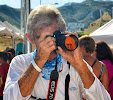
Padre Lucas earned his nickname after performing a “sham” marriage ceremony between members Fred and Ginger Harleman in the small Diaz chapel in Bahia de Los Angeles back in the seventies.
Over the years, Baja has attracted huge numbers of visitors seeking ‘fun in the sun’, but finding so much more. I suppose the highest percentage of these have flown to Los Cabos or La Paz, enjoying what they found there and returning time after time.
However, many have ventured farther into the unpopulated areas as the villages grew into towns and took on new personalities.
Some have not been able to resist driving the peninsula exploring the nooks and crannies until they find that certain place that fits them like a glove. Often they settle in that spot and make it their home away from home. This seems to be the real backbone of Baja.
Recently I received an email from Vagabundos Del Mar Boat and Travel Club announcing a tournament honoring one of their oldest members, Ralph ‘Padre’ Lucas, who had hosted the first event back in 1974 in Bahia de Los Angeles, (Bay of LA).
The email told about that first Vag Yellowtail Tournament which was held out of Papa Diaz’ Hotel over Memorial Day. Padre Lucas earned his nickname after performing a “sham” marriage ceremony between members Fred and Ginger Harleman in the small Diaz chapel in Bahia de Los Angeles back in the seventies.
Then Mama Diaz would charge $4 per person for rice, beans, turtle and Margaritas. If you wanted to get her on your good side, you would bring her gifts of candy, Motrin and cheese. She would always ask Padre to taste the clay bowl of Margaritas and of course he would say, “More tequila”!
Primitive by most standards, Bay of LA is still one of the most beautiful bays of Baja. It is approximately 400 miles south of the Mexican-U.S. border and is reached by traveling south on Transpeninsular Highway Baja 1 to a turnoff at Punta Prieta. The entire drive takes about ten hours.
Over the years, this small fishing community has spread along the shoreline to accommodate a population of approximately 700. Services include a handful of well-run trailer parks and small motels, a launch ramp, three Pemex stations, grocery stores, a pharmacy, a museum, a medical clinic plus two runways for small airplanes along with many places to camp.
Excellent yellowtail and bottom fishing and easy access to this remote fishing village has changed little from the way it was in 1974. Today’s residents and visitors to Bahia de los Angeles can still enjoy that ‘Old Baja’ ambiance and some of Baja’s most beautiful and varied coastal seascapes as well as some killer yellowtail action.
The prized yellowtail can usually be found farther down in the water column, roughly at 90 to 100 feet. The best nearby action is often centered at the northern end of large Isla Smith (also called Coronado), where double-digit sized yellows can be caught on iron and bait over sand/gravel bars. Any of the inner islands can be good as can the deeper water surrounding the many points dotting the shoreline on the inside the bay.
According to Jay Hammer, Vag member and Tournament director, the yellows are showing in big numbers this year. The tournament will be a three day tournament on June 26, 27 and 28, 2009, with awards each day at Casa Diaz. Awards for the top three yellowtail and the top three other sport fish each day. Grand Champion for the combined weight of yellowtail plus other fish. You will need a Mexican fishing license. For updates email Jay Hammer at jayshammer@aol.com .
For those of you who are nervous about driving in Baja, caravanning to Mexico has been the mode for the Vagabundos for 43 years. There is a Travel Buddies Calendar to connect those who wish to travel with a buddy. Call the Vag office at 800-474-BAJA, or 800-474-2252, for more details.
More Bay Of Los Angeles info
http://www.bahiadelosangeles.info

